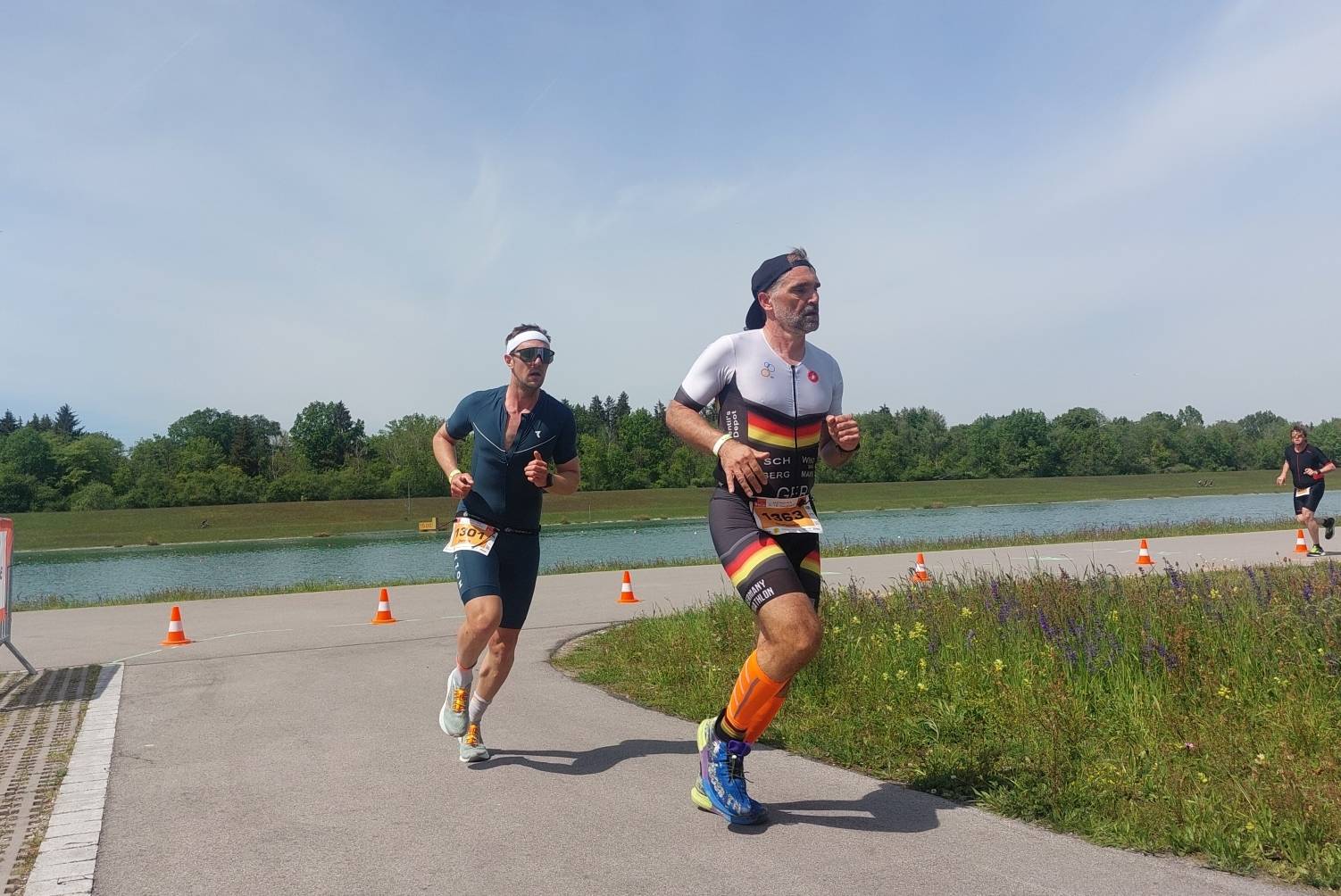Der Laufpart der Mitteldistanz gilt als besonders anspruchsvoll. Denn über die 21 Kilometer kann noch richtig Tempo gemacht werden. Wer allerdings zu viel riskiert, trifft schnell auf den berühmten Mann mit dem Hammer. Wie ihr euch am besten darauf vorbereiten könnt, erfahrt ihr hier.
Der Begriff Mitteldistanz definiert im Triathlon Wettkampfstrecken, deren Länge in etwa dem Doppelten der olympischen Distanz entspricht, bzw. der Hälfte einer Langdistanz oder eines „Ironman“. Gelaufen werden in der Regel also Strecken um die 20 Kilometer. Während internationale Topathleten dabei immer öfter die Schallmauer von einer Stunde und zehn Minuten unterschreiten, benötigen Einsteiger auf der Mitteldistanz bis zu zwei Stunden und 30 Minuten.
Kraftausdauerfähigkeit entscheidet
Es ist aber nicht allein die Endzeit, die die Topathleten von den Hobbysportlern unterscheidet, sondern insbesondere die Tatsache, dass Erstere in der Lage sind ihr Tempo auch auf der zweiten Streckenhälfte konstant zu halten, oder, sofern es um den Sieg geht, eventuell sogar zu steigern. Der Unterschied liegt in den jeweiligen Kraftausdauerfähigkeiten begründet, und eben diese gilt es auf der Mitteldistanz gezielt zu trainieren, um einen überproportionalen Leistungseinbruch kurz vor der Ziellinie zu vermeiden.
Der gesteigerte Dauerlauf
Als reine Laufeinheit besonders effektiv ist der gesteigerte Dauerlauf über 15 bis 25 Kilometer. Gestartet wird dieser Lauf bei einer Geschwindigkeit, die in etwa 20 Prozent über der individuellen Halbmarathon-Bestzeit liegt. Sukzessive wird dann die Geschwindigkeit soweit erhöht, bis sie am Ende der Einheit bis zu 10 Prozent unter der individuellen Halbmarathon-Bestzeit liegt. Die Aufteilung eines 25 Kilometer Laufs könnte für einen Triathleten mit einer Halbmarathon-Bestzeit von 1 Stunde 25 Minuten (Geschwindigkeit 4 Minuten pro Kilometer) folgendermaßen aussehen:
Einheit 1 – Gesamtdauer 90-105 Minuten
Kilometer 0: Start bei einer Geschwindigkeit von 4:45 / km
Kilometer 6: Erhöhen der Geschwindigkeit auf 4:25 / km
Kilometer 12: Erhöhen der Geschwindigkeit auf 4:00 / km
Kilometer 18: Erhöhen der Geschwindigkeit auf 3:35 / km
Kilometer 24: Ende der Einheit
Folgendes ist bei dieser Trainingsform unbedingt zu beachten: sobald die Zielgeschwindigkeit nicht mehr gehalten werden kann, sollte die Einheit in jedem Fall beendet werden. Entscheidend ist hier nicht, wie etwa beim langen langsamen Dauerlauf, die Anzahl der letztlich tatsächlich gelaufenen Kilometer oder Stunden, sondern die kontinuierliche Steigerung auf ein anspruchsvolles Temponiveau. Sofern sich die Zielzeiten bei der ersten Durchführung als zu ambitioniert erweisen, müssen diese entsprechend so angepasst werden, dass die angestrebte Distanz tatsächlich durchgelaufen werden kann.
Das Fahrtspiel
Ein solch spezifisches Kraftausdauertrainings kann auch als Fahrtspiel durchgeführt werden, beispielsweise in folgender Form wiederum am Beispiel unseres 1 Stunde 25 Minuten-Triathleten:
Einheit 2 – Gesamtdauer 90-120 Minuten
Kilometer 0: Start bei einer Geschwindigkeit von 4:25 / km
Kilometer 4: Erhöhen der Geschwindigkeit auf 3:35 / km
Kilometer 8: Verringern der Geschwindigkeit auf 4:25 / km
Kilometer 12: Erhöhen der Geschwindigkeit auf 3:35 / km
Kilometer 16: Verringern der Geschwindigkeit auf 4:25 / km
Kilometer 20: Erhöhen der Geschwindigkeit auf 3:35 / km
Kilometer 24: Ende der Einheit
Auch hier ist entscheidend, dass der zuletzt gelaufene Abschnitt immer ein schneller Abschnitt ist, an den sich aber natürlich noch ein kurzes Auslaufen anschließen kann.
Sowohl für Einheit 1 als auch 2 eignen sich daher besonders Rundkurse, die dann mehrmals durchlaufen werden. Dadurch fällt die Tempokontrolle leichter und Faktoren wie Topografie etc. üben keinen ungerichteten Einfluss aus.
Der Koppellauf
Einheit 3 – Gesamtdauer (nach Radfahren) ca. 30 min
Besonders spezifisch ist natürlich kraftausdauerorientiertes Lauftraining im Anschluss an eine längere Radausfahrt von zwei bis drei Stunden, wie sie zur Vorbereitung auf eine Mitteldistanz sicher öfter absolviert wird. Dieser Koppellauf ist dann wesentlich kürzer als die oben beschriebenen Einheiten, aber besonders kraftorientiert. Für die Durchführung notwendig ist eine moderate Steigung, die kraftintensives, aber noch sauberes Laufen zulässt. Diese Steigung wird in Belastungsintervallen von circa drei Minuten insgesamt fünf bis sechsmal durchlaufen, wobei die locker gelaufene Rückkehr zum Ausgangspunkt als Intervallpause dient. Wichtig ist es bei dieser Einheit bergan auf einen sauberen Abdruck und eine stabile Hüfte zu achten. Das Tempo sollte eher moderat gewählt werden, sodass noch ein optimaler Laufstil realisiert werden kann.
Ernährung testen
Insbesondere die Einheiten eins und zwei eignen sich hervorragend, um auch seine Ernährungsstrategie im Wettkampf zu testen. Viele Athleten haben bei der erhöhten Belastung im Wettkampf plötzliche Probleme mit der Aufnahme von Getränken etc., die sie bei moderatem Tempo ohne weiteres vertragen. Wenn im Rahmen der schnellen Abschnitte der oben beschriebenen Trainingseinheiten keine Probleme auftreten, dann sollte auch im Wettkampf einem starken Finish nichts mehr im Wege stehen.





















2 Kommentare
Friedrich
Hoffe, dass es Andrej wieder besser geht!
Sören
Liegt bei Einheit 2 die Durchschnittliche pace nicht nahe bei 4min/km und damit auf Höhe der HM PB? Das wäre über 24km demnach schwer machbar, oder :-) !